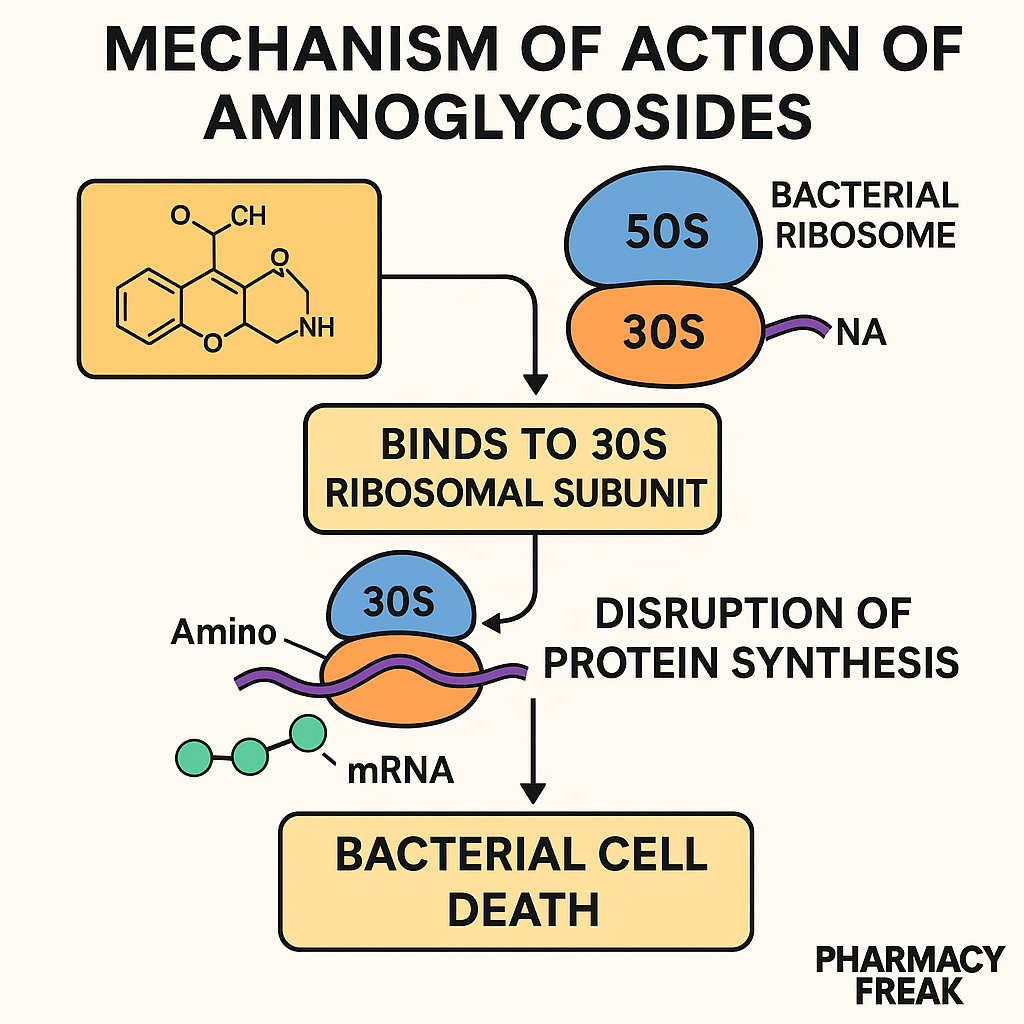Table of Contents
Introduction
Aminoglycosides are potent bactericidal antibiotics used mainly against aerobic Gram-negative bacilli and serious systemic infections. Common examples include gentamicin, amikacin, tobramycin, streptomycin, and neomycin. Unlike most protein synthesis inhibitors, aminoglycosides are bactericidal, not bacteriostatic. They bind to the 30S subunit of the bacterial ribosome and cause misreading of mRNA, leading to faulty protein synthesis and bacterial death.
They are a high-yield topic in USMLE, NCLEX, GPAT, and NEET-PG, particularly due to their unique properties, synergy with β-lactams, and nephrotoxicity.
Stepwise Mechanism of Action of Aminoglycosides
- Initial entry via porins in outer membrane
Penetration of the outer membrane of Gram-negative bacteria occurs through porin channels. - Oxygen-dependent active transport across inner membrane
Transport into the cytoplasm is energy-dependent, requiring aerobic conditions — hence, ineffective in anaerobic environments. - Binding to 30S ribosomal subunit
Aminoglycosides bind irreversibly to the 16S rRNA of the 30S subunit. - Interference with initiation complex formation
This prevents the assembly of the functional ribosome, halting protein synthesis. - Misreading of mRNA
Causes incorrect amino acid incorporation, producing non-functional or toxic proteins. - Disruption of bacterial membrane
Faulty proteins may insert into the cell membrane, increasing membrane permeability, causing leakage and death.
Pharmacokinetic Parameters of Aminoglycosides (e.g., Gentamicin)
| Parameter | Value |
|---|---|
| Bioavailability | Poor orally; given IV/IM |
| Half-life | 2–3 hours |
| Protein binding | Low (~10%) |
| Metabolism | Not metabolized |
| Excretion | Renal (unchanged) |
| Volume of distribution | Extracellular fluid compartment |
Clinical Uses of Aminoglycosides
- Severe Gram-negative infections (Pseudomonas, Klebsiella, E. coli)
- Sepsis and bacteremia
- Endocarditis (in combination with penicillin/vancomycin)
- Tuberculosis (streptomycin as second-line)
- Pelvic and abdominal infections (synergistic use)
- Bowel sterilization before surgery (neomycin, oral)
- Plague and tularemia
Adverse Effects of Aminoglycosides
- Nephrotoxicity (dose-dependent, reversible)
- Ototoxicity (irreversible; affects cochlea and/or vestibule)
- Neuromuscular blockade (rare but life-threatening)
- Teratogenicity (Category D – avoid in pregnancy)
- Allergic reactions (rare)
Monitor renal function and drug levels in prolonged therapy.
Comparative Analysis: Gentamicin vs Amikacin
| Feature | Gentamicin | Amikacin |
|---|---|---|
| Spectrum | Gram– (moderate) | Broad (including resistant strains) |
| Ototoxicity risk | Higher (vestibular) | Lower (more cochlear) |
| Use in TB | No | Yes (less preferred) |
| Cost & availability | Cheaper, widely available | Costlier, reserved use |
| Resistance | Higher due to modifying enzymes | Lower (less susceptible) |
Practice MCQs
Q1. What is the ribosomal target of aminoglycosides?
a. 50S subunit
b. 30S subunit ✅
c. RNA polymerase
d. Topoisomerase
Q2. Aminoglycosides are ineffective in:
a. Aerobic Gram– bacilli
b. Anaerobic infections ✅
c. UTIs
d. Endocarditis (with synergy)
Q3. Which adverse effect is irreversible?
a. Nephrotoxicity
b. Ototoxicity ✅
c. Nausea
d. Rash
Q4. Aminoglycosides inhibit bacterial protein synthesis by:
a. Inhibiting DNA polymerase
b. Disrupting membrane potential
c. Causing mRNA misreading ✅
d. Blocking tRNA binding
Q5. Why are aminoglycosides used with β-lactams?
a. Reduce resistance
b. Improve renal function
c. Synergistic killing ✅
d. Enhance absorption
Q6. Which aminoglycoside is used in TB?
a. Gentamicin
b. Streptomycin ✅
c. Neomycin
d. Tobramycin
Q7. Aminoglycoside excretion route is:
a. Liver
b. Skin
c. Lungs
d. Kidneys ✅
Q8. Which route is preferred for systemic use?
a. Oral
b. IV or IM ✅
c. Rectal
d. Intrathecal
Q9. Which electrolyte imbalance can aminoglycosides cause?
a. Hypernatremia
b. Hypocalcemia
c. Hypomagnesemia ✅
d. Hyperkalemia
Q10. What is the function of 16S rRNA site in aminoglycoside action?
a. Peptide bond formation
b. Ribosome assembly
c. mRNA decoding ✅
d. Translocation
FAQs
Q1: Are aminoglycosides safe in pregnancy?
No, they are Category D, with risk of fetal ototoxicity.
Q2: Can they be used orally for systemic infections?
No, oral absorption is negligible; only local gut action.
Q3: Do aminoglycosides cross the BBB?
Poorly. Use intrathecal/intraventricular routes in meningitis.
Q4: Why is once-daily dosing used?
It maximizes concentration-dependent killing and reduces toxicity.
Q5: What is the synergistic combination with penicillin used for?
Mainly in enterococcal endocarditis and other Gram+ infections.
References
- KD Tripathi – Essentials of Medical Pharmacology
- Goodman & Gilman – The Pharmacological Basis of Therapeutics
- Sparsh Gupta – Review of Pharmacology
- NCBI: https://www.ncbi.nlm.nih.gov/books/NBK548555/

I am pursuing MBA in pharmaceutical management from NIPER Hyderabad with a strong academic record and proven success in national-level pharmacy entrance exams. I secured AIR 61 in NIPER 2024 (MS/M.Pharm) and AIR 27 in NIPER MBA, along with AIR 147 in GPAT 2024 and AIR 907 in GPAT 2023. I also achieved AIR 6 in AIIMS CRE-2025 for Drug Store Keeper and was selected as a Pharmacist (AIR 61) for ESIC. Additionally, I was the Runner-Up in Round 2 of the EY Case Study Competition.
At PharmacyFreak.com, I aim to guide future pharmacists through expert content, exam strategies, and insightful resources based on real experience and academic excellence.
Mail- harsh@pharmacyfreak.com
